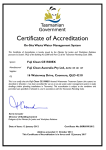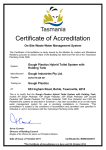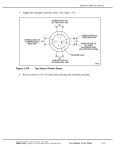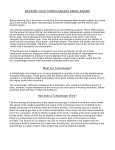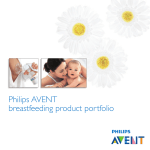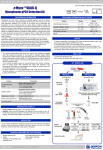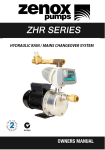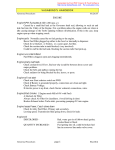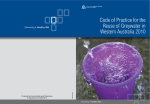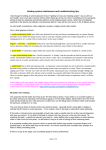Download BSR0621/2012 - Department of Justice
Transcript
Certificate of Accreditation On-Site Waste Water Management System This Certificate of Accreditation is hereby issued by the Minister for Justice and Workplace Relations pursuant to Section 59(2) of the Building Act 2000 and Part G2 of the Tasmanian Plumbing Code 2006. System: Envirocycle (Tas) 10ANR Manufacturer/ Professional Plumbing Pty Ltd Supplier: ACN 009 580 705 Of: 91 Lampton Ave, Derwent Park TAS 7009 This is to certify that the Envirocycle (Tas) 10ANR Aerated Wastewater Treatment System (the system), as described in Schedule 1, has been accredited for use as an on-site waste water management system in single dwellings (within plumbing installations in Tasmania). This accreditation is subject to the conditions and permitted uses specified in Schedule 2, and in accordance with the Tasmanian Plumbing Code. Kerrie Crowder Director of Building Control delegate of the Minister for Justice and Workplace Relations Date of Issue: 17 May 2012 Certificate No: BSR0621/2012 This Certificate of Accreditation is in force until 16 May 2017 Page 1 of 16 Department of Justice - Certificate of Accreditation BSR0621/2012 SCHEDULE 1: Specification Envirocycle (Tas) 10ANR Aerated Wastewater Treatment System General Description The Envirocycle (Tas) 10ANR (‘the system’) collects and treats domestic wastewater. For treatment system schematic drawings and flow path, refer to Appendix A. For Engineering drawings refer to Appendix B. For treatment system components list, including concrete tank specifications, refer to Appendix C System Components The system consists of one 6388L vertical-axis pre-cast reinforced concrete cylinder containing: • • • • • • • • • • A 1478L primary sedimentation anaerobic chamber; A 1698L anerobic filtration chamber; A 2065L contact aeration chamber A timer-controlled Air Blower which operates at 80 L/minute when timed on; A 407L secondary sedimentation chamber; A 336L pump-out/disinfection chamber housing a chlorine dispenser and a submersible irrigation pump; High level float switches; A sludge return system in the secondary sedimentation chamber constructed of UPVC pipe and operated by the Air Blower; A Control module and programmable logic controller (PLC) air blower timer; and An audio-visual alarm system. Certification to AS/NZS 1546.3 for systems manufactured at 91 Lampton Ave, Derwent Park, Tasmania has been given by Geo Environmental Solutions (Hobart). The system is designed to treat a maximum Hydraulic Load of 2500 Litres of domestic wastewater per day from residential premises. The Raw Influent used in the testing of the system met the requirements of AS/NZS 1546.3:2008 Appendix A4.1. Energy consumption The estimated Electricity Usage is based on a 4 person household with average wastewater flows and loads. Electrical Equipment Watts Daily operation kWh/year Estimated (hours) specified Annual Cost by manufacturer @ ~$0.25/kWh Air Blower - Zenox 60 18 394 $99 * Irrigation pump -Zenox ZHS040 400 1.5 219 $55 Controller & remote alarm - Matelec 2.4 24 21 $5 * Note: The irrigation pump hours of operation may vary depending on influent flow volume. Also, a pump with different specifications to the Zenox ZHS040 may have to be installed where the head and flow performance is not adequate for the site conditions. Therefore, this will result in an adjustment to the estimated annual energy costs. Date of issue: 17 May 2012 Director, Building Control delegate of Minister for Workplace Relations Page 2 of 16 Department of Justice - Certificate of Accreditation BSR0621/2012 Description of Treatment Processes Wastewater enters the primary (anaerobic septic) chamber where the bulk of the organic and inorganic solids are retained, by either settling to the bottom of the chamber or floating to the surface. The clarified sewage flows into a second anaerobic settling (filtration) chamber before passing into the aeration chamber. Organic material in the wastewater is consumed by anaerobic microbes in the first two chambers and by aerobic microbes in the aeration chamber (see Figure 1 and Appendix A). The 80 litre per minute air blower forces air through micro diffusers located in the aeration chamber. This supplies oxygen to aerobic microbes in the biomass suspended within the water column and attached to the fixed media. Figure 1 General View The Blower is pre-set to operate on a pre-determined on/off cycle throughout a 24 hour period in order to provide aeration which matches the design organic loading and achieves the design nitrogen/nutrient reduction. The biologically treated water flows from the aeration chamber into the clarification/sedimentation chamber to allow settling of suspended particles to occur. A sludge return pipe located in the clarification/sedimentation chamber transfers accumulated settled sludge back to the primary chamber for further treatment. The clarified effluent is then disinfected as it flows over chlorine tablets into the effluent storage chamber (pump-well). A float switch attached to the pump controls it to periodically discharge the effluent to the irrigation field. A high-level alarm located in the pump well detects high water levels. Emergency storage capacity of not less than 1000 litres without cross contamination in accordance with clause 2.4.8 of AS/NZS 1546.3:2008 is provided within the primary treatment chambers of the system. The primary tank is de-sludged every five years or less as deemed necessary by the service contractor. The system is fitted with a control panel containing a programmable logic controller (PLC). The system is designed to treat all household wastewater from the kitchen, bathroom, toilet and laundry. Date of issue: 17 May 2012 Director, Building Control delegate of Minister for Workplace Relations Page 3 of 16 Department of Justice - Certificate of Accreditation BSR0621/2012 Hydraulic and organic loading and effluent quality Influent Design flow, as specified by the manufacturer, • Daily flow (maximum hydraulic load) 250 litres per person, 10EP = 2500 litres Organic loading, as specified by the manufacturer, • • • • Daily BOD5 70 grams per person, 10EP = 700 grams per day Daily TSS 70 grams per person, 10EP = 700 grams per day Daily Nitrogen 15 grams per person 10EP = 150 grams per day Daily Phosphorus 2.5 grams per person, 10EP = 25 grams per day Effluent The effluent test results for 90% of samples tested showed: • • • • • BOD5 less than or equal to 20.0 mg/L TSS less than or equal to 30.0 mg/L. E. coli less than or equal to 10cfu/100mL Total nitrogen concentrations less than or equal to 50 mg/L Total phosphorous concentrations less than or equal to 5 mg/L Date of issue: 17 May 2012 Director, Building Control delegate of Minister for Workplace Relations Page 4 of 16 Department of Justice - Certificate of Accreditation BSR0621/2012 Schedule 2: Conditions of Accreditation 1.0 Definitions In this schedule: AS/NZS 1547 means the Joint Australian/New Zealand Standard ‘AS/NZS 1547:2000 On-site domesticwastewater management’; AS/NZS 1546.3 means the Joint Australian/New Zealand Standard ‘AS/NZS 1546.3:2008 On-site domestic wastewater treatment units, Part 3: Aerated wastewater treatment systems’; AS/NZS 3000 means the Joint Australian/New Zealand Standard ‘AS/NZS 3000:2000 Wiring rules’ AS/NZS 5667 means the Joint Australian/New Zealand Standard ‘AS/NZS 5667.1:1998 Water quality – Sampling, Part 1: Guidance on the design of sampling programs, sampling techniques and preservation and handling of samples’; BOD5 means ‘5-day Biochemical Oxygen Demand’; cfu means colony forming unit Council means ‘the Municipal Council having jurisdiction’; Commissioned means ‘when the test results from a NATA Certified Laboratory show that the water quality requirements for the AWTS have been met and all pre-commissioning tests have been carried out in accordance with AS/NZS 1547 on all associated equipment and land application system’; Designer means ‘a person who is accredited under the Building Act 2000 or a Plumber who has a specialty in the area of designing on-site waste water management system installations,; Director means ‘the Director of Building Control’; EC means electrical conductivity E. coli means ‘Escherichia coli of the family Enterobacteriaceae which is a bacterium used in public health as an indicator of faecal pollution’; g/m3 means grams per cubic metre Manufacturer means ‘Professional Plumbing Pty Ltd’; NATA means ‘National Association of Testing Authorities’; PCA means ‘Vol. 3 of the National Construction Code (Plumbing Code of Australia)’; Permit means ‘a Permit issued by the council pursuant to section 82 of the Building Act 2000’; Permit authority means ‘a person or body authorised for that purpose by the council of the municipal area in which the on-site waste water management system is installed’; Plumber means a person who holds an appropriate class of licence under the Occupational Licensing Act 2005 as a Plumber Practitioner (Certifier). Supplier means ‘the party that is responsible for ensuring that products meet and, if applicable, continue to meet, the requirements on which the certification is based.’ The supplier for the Envirocycle (Tas) 10ANR is ‘Professional Plumbing Pty Ltd.’ System means ‘Envirocycle (Tas) 10ANR’ TPC means the ‘Tasmanian Plumbing Code’. TSS means ‘Total Suspended Solids’. Date of issue: 17 May 2012 Director, Building Control delegate of Minister for Workplace Relations Page 5 of 16 Department of Justice - Certificate of Accreditation BSR0621/2012 2.0 General 2.1 The system must be supplied, constructed and installed in accordance with the design submitted and accredited by the Director. 2.2 The system must not be installed or used in a plumbing installation other than in accordance with the conditions of the permit issued by the Permit Authority. 2.3 Each system must be permanently and legibly marked on a non-corrosive metal plaque or equivalent, attached to the lid with the following information: 2.4 • The brand and model name or designation of the system; • The manufacturer’s name or registered trademark; • Top load limitations; and • The month and year of manufacture. The supplier must supply the owner and occupier of each installation with a user manual setting out the following: (a) (b) (c) (d) (e) the treatment process; procedures to be followed in the event of a system failure; emergency contact number; care, operation, monitoring and maintenance requirements; and inspection and sampling procedures to be followed as part of the on-going monitoring and program required by the permit authority. 2.5 Any proposed modifications to the system’s specified processes, equipment, materials, fittings or manuals must have prior authorisation in writing from the Director and may be subject to additional verification or testing. 2.6 Each application to a permit authority to install a system must be accompanied by a site-and-soil evaluation report and design report in accordance with AS/NZS 1547 as appropriate. 2.7 The supplier must provide the following information to each permit authority where it is intended to install a system in their jurisdiction: • Statement of warranty • Statement of service life • Quality Assurance Certification • Installation Manual • Service Manual • Owner’s Manual • Service Report Form • Engineering Drawings on A3 format • Detailed Specifications • Certificate of Accreditation and Schedules. 2.8 This Certificate of Accreditation is valid for five (5) years from the date of issue or until withdrawn by the Director and is not transferable. Any application for variation or renewal must be accompanied by Product Certification that has been issued by a JAS-ANZ accredited Conformity Assessment Body (CAB) and other required documentation in accordance with the latest Application for Accreditation Form. 2.9 At each anniversary of the accreditation date the supplier must submit to the Director a list of all systems installed in Tasmania during the previous 12 months. The Director may randomly select up to 10% of the installed systems from each year of installation. The Director will notify the supplier’s nominated NATA accredited laboratory which systems are to be sampled and tested for BOD5 and Date of issue: 17 May 2012 Director, Building Control delegate of Minister for Workplace Relations Page 6 of 16 Department of Justice - Certificate of Accreditation BSR0621/2012 TSS and Chlorine residual. The sampling and testing of the selected systems is to be done at the supplier’s expense. The following results must be reported to the Director: • Address of premises; • Date inspected and sampled; • Sample identification number; • Chlorine Residual; • BOD5; • TSS; • Total nitrogen concentrations • Total phosphorous concentrations and • Service history 2.10 Where, due to a design fault, the system has been found not to operate satisfactorily during its service life and as a result requires modification to achieve the required water quality limits, all installed systems are to be modified accordingly. 2.11 When granting a permit the permit authority is to satisfy itself that the designer’s choice of the system configuration is optimal for the proposed use and site conditions. 2.12 The system must not be deployed to areas where seasonal climatic conditions will negatively affect its proper operation (refer to manufacturer’s specifications). 2.13 Prior to the granting of a permit to install a system the following reports must be submitted with an application to the permit authority: Site-and-soil evaluation report The site and soil evaluation report is to detail results of an assessment of the individual lot(s) for the public health, environmental, legal and economic factors which are likely to impinge on the location and design of a land-application system. (Refer to AS/NZS 1547 Clause 4.1.5 and associated appendices to 4.1). Design report The Design Report is to include the following: (a) Relevant aspects of the Site-and-soil Evaluation Report. (b) A report on the selection of the land-application system. (Refer to AS/NZS 1547, Clause 4.2.4 and associated appendices to Clause 4.2 for further information). (c) A report on the selection of the wastewater-treatment unit. (Refer to AS/NZS 1547, Clause 4.3.6 and associated appendices to Clause 4.3 for further information). (d) Sufficient information to show that the relevant performance requirements set out in the PCA have been met. (e) A loading certificate which sets out the design criteria and the limitations associated with use of the system and incorporates such matters as: (i) System capacity (number of persons and daily flow); (ii) Summary of design criteria; (iii) The location of and use of reserve areas; (iv) Use of water efficient fittings, fixtures, or appliances; (v) Allowable variation from design flows (peak loading events); (vi) Consequences of changes in loading (due to varying wastewater characteristics); (vii) Consequences of overloading the system; (viii) Consequences of underloading the system; Date of issue: 17 May 2012 Director, Building Control delegate of Minister for Workplace Relations Page 7 of 16 Department of Justice - Certificate of Accreditation 2.14 BSR0621/2012 (ix) Consequences of lack of operation, maintenance and monitoring attention; and (x) Any other relevant considerations related to the use of the system. The following reports must be submitted to the permit authority and owner and be made available to the Director upon request after commissioning of the system: • Installation and commissioning report The Installation and Commissioning Report is to cover the ‘as-constructed’ records of the system installation together with the results of commissioning tests to demonstrate correct construction and installation and is to be provided to the owner and permit authority on completion of the work. (Refer to and AS/NZS 1547 Clause 4.5.6.3 and associated appendices to Clause 4.5). • Inspection and Maintenance Report Maintenance reports cover ongoing inspection and maintenance operations in order to monitor the operation of the installation. (Refer to AS/NZS 1547 Clause 3.7.4 and associated Appendix 3A). 2.15 Where the supplied pump is not suitably rated for the proposed land application area it must be replaced with a pump which has a rated capacity that matches the hydraulic characteristics of the irrigation system and be capable of discharging at least 50% more than the 30 minute flow rate. For drip irrigation systems, ensure that drip emitter flow rates do not vary more than 10% from the design rate over the whole of the system when installed on a sloping site. Note: The pump selection is to be based on flow, head loss and pressure requirements. 2.16 Effluent distribution by sub-surface application may be permitted where the Permit Authority is satisfied that the application for a permit to install the system has demonstrated that the: (a) effluent can be retained within the authorised land application area; (b) where applicable the land application system has been designed and is capable of being installed and maintained in accordance with AS/NZS 1547; (c) the location of the land application system satisfies the relevant requirements of the State Policy on Water Quality Management 1997; and (d) the discharge is capable of satisfying the relevant water quality limits (see 5.7). 3.0 Installation and Commissioning 3.1 The installation and operation of the system must comply with the conditions of accreditation and the manufacturer’s instructions. 3.2 All plumbing work carried out in connection with the system installation must satisfy the requirements of the Building Act 2000, TPC and the Tasmanian Plumbing Regulations and be carried out by a registered plumber with appropriate training and qualifications. 3.3 All installations of the system must satisfy the installation requirements set out in Appendix A1 – Onsite Waste Water Management Systems of the TPC. 3.4 All electrical work must be carried out by a licensed electrician and in accordance with relevant provisions of AS/NZS 3000. 3.5 The system requires a 240V AC power supply. A weather-proof isolating switch must be provided at the power outlet. The power supply must have its own clearly marked designated circuit breaker in the electricity supply fuse box. 3.6 Each system installation must be inspected and checked by the designer or the designer’s agent. The designer on completion is to certify that the system has been constructed, installed and commissioned in accordance with its design, the conditions of accreditation and any additional requirements set out in the permit. Note: Where the designer is not available to supervise the installation the designer should obtain signed certification from the installing plumber stating that the installation has been constructed/installed and commissioned in accordance with its design, the conditions of permit. Date of issue: 17 May 2012 Director, Building Control delegate of Minister for Workplace Relations Page 8 of 16 Department of Justice - Certificate of Accreditation BSR0621/2012 3.7 Where discharging wastewater to a land application system by irrigation, a lockable sampling tap or gate valve is to be provided on the outlet pipe to the irrigation system. 3.8 A report is to be prepared by the council approved plumbing contractor detailing the inspection of the installation and the results of the commissioning tests and be accompanied by a certificate certifying that the system is operating and performing adequately . 3.9 Copies of the following reports/certificates must be submitted to the council and the owner as soon as practicable after the commissioning of the system and after each scheduled or unscheduled service or inspection for the period specified in the permit: (a) The initial plant installation and commissioning report; (b) All required laboratory analytical test reports; and (c) All inspection and maintenance reports 3.10 Copies of any report or certificate required by the conditions of accreditation must be made available to the Director on request. 3.11 The designer is to provide a statement warning the user of which items and products that must not be placed in the system. 3.12 To verify that the plant is commissioned, sampling must be carried out, by a council approved person, for BOD5, TSS and Free Residual Chlorine. The samples are to be tested and reported on by a NATA certified laboratory. 4.0 Maintenance and monitoring 4.1 Each installation must be serviced and monitored at not less than 3 monthly intervals in accordance with the conditions of accreditation, the conditions of permit and manufacturer’s requirements. Notes: 1. Only a plumber can carry out the maintenance and required monitoring of the system other than electrical work unless licensed to do so. 2. The plumber may need to complete training by the supplier before carrying out any maintenance on the system. 3. The maintenance and monitoring intervals may be combined provided the monitoring frequency remains at 3 month intervals. 4.2 The owner of the system must enter into and maintain a maintenance contract with the council, the supplier of the system, or other council approved plumbing contractor. 4.3 The owner must enter into an agreement with the council to maintain the maintenance contract where that contract is with the supplier of the system or other council approved plumbing contractor. 4.4 The system must be operated and maintained to ensure it performs continuously and without any intervention between inspections carried out by the council approved plumbing contractor. 4.5 A service report is to be prepared by the plumbing contractor who carried out the work detailing the inspection of the installation and the results of all servicing tests and conditions at the completion of all scheduled or unscheduled services or inspections. 4.6 The service report is to be accompanied by a signed document certifying that the system is operating and performing adequately. 4.7 A copy of the service report and certifying document is to be provided to the occupant and council. Each service report is to contain a statement reminding the user about items and products that must not be placed in the system. Date of issue: 17 May 2012 Director, Building Control delegate of Minister for Workplace Relations Page 9 of 16 Department of Justice - Certificate of Accreditation BSR0621/2012 4.8 Each service must include monitoring the operation of the system and associated land application system. 4.9 Maintenance must be carried out on all mechanical, electrical and functioning components of the system as appropriate. 4.10 The monitoring, servicing and reporting of the installation must include but not be restricted to the following matters, as appropriate: (a) Reporting on weather conditions, ambient temperature, effluent temperature; (b) Odour; (c) Check and test pump (d) Check and test air blower, fan or air venturi and clean/replace air filters; (e) Check and test alarm system; (f) Check slime growth on membranes and report the on condition of membranes; (g) Check and report operation of sludge return, sludge level and de-sludging; (h) Check and record water meter reading (if fitted); (i) Check and record operation of irrigation area, irrigation fittings; (j) Check and clean/replace irrigation filters; (k) Check and report on water quality (testing for pH, Turbidity, EC and dissolved oxygen); (l) Check, and replenish chlorine disinfection system; (m) Cleaning of the following items at above the waterline– I. clarifier, II. pipework, III. valves IV. walls of chambers 5.0 Performance 5.1 Hydraulic and Organic Loading: The system is accredited for treatment of domestic wastewater from residential and commercial premises with the following MAXIMUM hydraulic and organic loads: Model Max Hydraulic load (L/day) Biochemical Demand (g/day) Envirocycle (Tas) 10ANR 2500 700 Oxygen Treated effluent from the system must not exceed the following limits (90% of samples): For sub-surface irrigation: 5-day Biochemical Oxygen Demand (BOD5) Total Suspended Solids (TSS) For surface irrigation: 5-day Biochemical Oxygen Demand (BOD5) Suspended Solids (SS) E. coli Free Residual Chlorine concentrations Date of issue: 17 May 2012 20 g/m3 (max. 30 g/m3) 30 g/m3 (max. 45 g/m3) 20 g/m3 (max. 30 g/m3) 30 g/m3 (max. 45 g/m3) 10 cfu/100 mL (max. 20 cfu/100 mL) ≥ 0.5 g/m3and less than 2.0 g/m3 Director, Building Control delegate of Minister for Workplace Relations Page 10 of 16 Department of Justice - Certificate of Accreditation BSR0621/2012 6.0 On-going management 6.1 The mandatory servicing and monitoring is to commence 3 months after the plant is commissioned. The servicing and monitoring is to coincide with the supplier’s required on-going routine scheduled maintenance program. 6.2 Where a system installed at a site has been found not to operate satisfactorily during its service life, and as a result requires modification to achieve the required performance requirements, in particular, water quality limits, the installed system is to be modified accordingly. Any modifications must be recorded on the service report. 6.3 In the event of failure to comply with the water quality limits set out in these conditions, fortnightly sampling and testing for BOD5, TSS and Free Residual Chlorine must be carried out until the plant is re-commissioned. 6.4 The method of preserving and the handling of samples taken from the plant must satisfy the relevant requirements of AS/NZS 5667. 6.5 Copies of the following reports and certificates must be submitted to the permit authority and the owner as soon as practicable after the commissioning of the system and after each scheduled or unscheduled service for the period specified in the permit: (a) the initial plant installation and commissioning report (b) all laboratory analytical test reports; and (c) all inspection and maintenance reports 6.6 The system is to be de-sludged every five years strictly in accordance with the manufacturer’s recommendations and the sludge is to be disposed of in accordance with the Tasmanian Biosolids Reuse Guidelines and the conditions of permit. 6.7 Only persons with a waste transport business Environment Protection Notice are to be engaged for the removal, transporting and disposal of accumulated sludge removed from the system. 6.8 Any waste material removed from the system must be collected and disposed of or utilised by an approved facility or agency. 6.9 Measures are to be put in place so that during servicing activities all persons and the environment will be protected from the results of the servicing activities. 7.0 Permitted uses 7.1 The effluent is suitable for land application by any of the following methods: (a) (b) sub-surface by: i. subsurface drip irrigation ii. trenches, beds, mounds, evapo-transpiration systems above ground by: i. spray irrigation ii. surface drip irrigation Note: Each of the above forms of Land Application is subject to consent from the permit authority and must be in accordance with the relevant provisions of AS/NZS 1547. 7.2 Where it is not practicable for effluent from the system to be applied in accordance with AS/NZS 1547, the method of discharge must satisfy contemporary relevant regulatory requirements to the satisfaction of the permit authority. Date of issue: 17 May 2012 Director, Building Control delegate of Minister for Workplace Relations Page 11 of 16 Department of Justice - Certificate of Accreditation BSR0621/2012 Appendix A - Schematic drawings, Process Flow Envirocycle (Tas) 10ANR Date of issue: 17 May 2012 Director, Building Control delegate of Minister for Workplace Relations Page 12 of 16 Department of Justice - Certificate of Accreditation BSR0621/2012 Appendix B - Engineering Drawings Date of issue: 17 May 2012 Director, Building Control delegate of Minister for Workplace Relations Page 13 of 16 Department of Justice - Certificate of Accreditation BSR0621/2012 Appendix B - Engineering Drawings Date of issue: 17 May 2012 Director, Building Control delegate of Minister for Workplace Relations Page 14 of 16 Department of Justice - Certificate of Accreditation BSR0621/2012 Appendix C Component list and specifications Date of issue: 17 May 2012 Director, Building Control delegate of Minister for Workplace Relations Page 15 of 16 Department of Justice - Certificate of Accreditation BSR0621/2012 Side elevation Plan Date of issue: 17 May 2012 Director, Building Control delegate of Minister for Workplace Relations Page 16 of 16
















